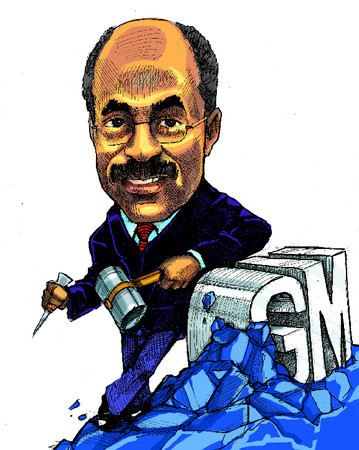First black auto designer revolutionized General Motors
Not even the shy 11-year-old boy, who was given the same name of his father in 1950 could have envisioned sitting where he is today.
The ghosts that wander through that office are legends. Their presence can still be felt on the street and in the very fabric of the country where they flourished.
The creations that came were legendary.
Isn't it amazing to sit there, inside the corner office, inside the still-chic General Motors Design Center in Warren, Mich., and be the kid from suburban Philadelphia, Pa., whose father owned a repair shop? To be Edward T. Welburn, the man with the pen strokes on the future of a "new" GM, a revamped GM when it emerges from bankruptcy.
To be just the sixth design king in the history of GM and finding the pinnacle of your career after just innocently asking the company in a letter penned when he was 11.
How do I get a job in this company, the kid wanted to know?
"I wanted to be a car designer," Welburn remembered during a conversation with various media members upon his announcement six years ago. "I wanted to know what courses to take in school, what university to attend and what I needed to be that car designer. They sent me information and I followed their lead."
Welburn couldn't have imagined where he would land, now sharing the head designer office with the ghosts of Harley Earl, Bill Mitchell and many others. All were design greats. And Welburn, 58, has taken his rightful place, designing cars that GM will need to pull through, from the amazingly elegant interiors of Cadillac to the resurgent Chevrolet Camaro to the future Chevy Volt electric car.
"There's a lot of responsibility sitting here," he said. "And I am trying my best to live up to that."
When Welburn replaced former designer Wayne Cherry as vice president of North American design in October 2003, business journalists thought he would be just as conservative. What they got was completely the opposite.
Welburn set out to create interesting and provocative cars to take GM to a new level and he created processes that sparked a revolution at a time when the company began valuing its designs again.
Welburn was so confident about the future of GM and the importance of raw expression that he reopened the automaker's Studio X, the legendary secret lair where designers could work on special projects without management interfering. One of the first cars to come from Studio X was the reborn Camaro, a vehicle that is now just hitting the streets.
Welburn also sought to integrate GM's 11 design centers in eight countries around the world, globalizing the process and allowing the company to work around the clock, from Detroit to Brazil to Europe to Asia and Australia.
Design and engineering became a closer unit and product development became king.
Suddenly things changed. Plastic dashboards were replaced by softer surfaces. Interior fabrics were as important as engines. And proportions were more closely in line as the vehicle went through development.
"I was here through it all," Welburn told Motor Trend magazine a few years ago. "There was a period of time in which other areas of the company pretty much set up the parameters of the car. Everything was nearly set before design was able to get involved in the development of the vehicle."
Welburn got things right. He helped create the Pontiac Solstice, the new Chevy Malibu, the resurgence of Cadillac and the strength of GM's full-size trucks, which became a huge source of pride and profit as the automaker turned itself around at the start of this century.
Not bad for a kid from Berwyn, just outside of Philadelphia, which was located down the street from racecar owner Roger Penske's first four-bay shop and Bill Jenkins' drag racing operation.
The young Welburn was hired by GM straight out of Howard University in Washington, D.C., and immediately went to work. When he began in 1972 there were no other African-American designers. He was the first.
He worked with Oldsmobile, Saturn and Opel and eventually found his way into the global lead position, all the while keeping his casual style -- his designers still call him "Ed" in the studio -- and he still loves driving vintage GM cars to work.
The 11-year-old letter writer had exceeded even his own dreams. Today the role is reversed. He still receives letters from young people. And of course he writes back.
"I feel very fortunate so I send them back the same information," he said. "Every kid should have the same chance I had."
Steven Reive is a feature writer with Wheelbase Communications. He can be reached on the Web at www.wheelbase.ws/mailbag.html. Wheelbase Communications supplies automotive news and features to newspapers across North America.





















